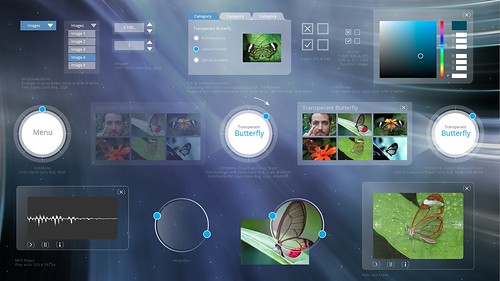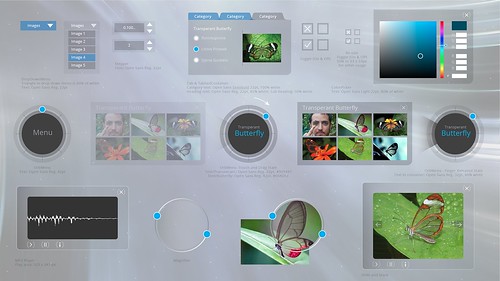Blog
Working on New Designs for the Open Exhibits Components
Open Exhibits software comes with over 50 UI elements and other libraries that can be used to construct multitouch and motion tracking applications and exhibits. Recently, we've begun redesigning many of the UI elements for a release later this summer. Below are a couple of examples of design direction we are going in.
Notice the light and dark version of these UI elements. We are trying to make this set of UI elements as universally adaptable as possible. Our UI elements can all be re-skinned, but having a more attractive starting point (these will be our "default" components) would be a step forward. Along with improved visual design, we've been reworking some of the functionality of these elements to make them more user friendly--there is still a bit of work remaining. You can see more of these designs on the Open Exhibits Flickr site. Let us know what you think.
Kickstart the DUO: The World's First DIY 3D Sensor
Have you heard of the DUO?
The DUO is the world’s first and only DIY 3D sensing solution. The DUO comes in many forms: with open hardware plans, molded cases, kits and fully assembled devices. All paired with an open source Driver, SDK and examples. Resulting in a professional grade solution for 3D sensing using stereo vision. The best part is it’s extremely easy to use, just plug it in, download the software and you can start playing within minutes. If you can wave in the air you can use a DUO.
What could be as cool as a multitouch screen? Multitouch without a screen. As multitouch moves into the third dimension, so does Open Exhibits. Our team is working on developing a library of 3D motion gestures and adding support for 3D motion sensing and other new HCI technologies. Integrating the DUO is on the roadmap. The DUO provides a DIY solution that museum techs should be keeping an eye on.
Help the DUO become a reality with their Kickstarter campaign.
New Exhibit Download: Flickr Collection Viewer Featuring Smithsonian's Women in Science
Open Exhibits has released a new exhibit template that allows users to dynamically search any Flickr collection and browse through digital result sets.
The exhibit includes retractable control stations, referred to as docks that guide users through query construction by vertically spinning a set of dials populated with predefined search terms. Each dial change submits a new query, as a combination of aligned dial terms, and generates a visual result set representation in the dock. Result sets can be horizontally scrolled and images can be loaded to stage by either tapping a result or dragging a result to one of the graphical placeholders. Once on stage, users can transform images with basic manipulation gestures, close images, and flip to info panels to view descriptions.
The exhibit is fully configured in CML and CSS to support easy customization of features like search term assignment, placeholder layout, number of query dials, text field attributes, etc. The accompanying documentation provides instruction on how to link your own Flickr sets and how to change the exhibit's style.
The exhibit, by default, uses the Women in Science Flickr set from the Smithsonian Institute.
Open Exhibits at Museums and the Web and AAM Annual Conferences
We have a couple of conferences coming up in April and May:

Museums and the Web in Portland, April 17-20. In addition to an exhibit booth, we will be doing a workshop on Open Exhibits, our free multitouch software for museums and educational institutions. The workshop will present exciting new developments for version 3.0 of the OE framework. Among else, we'll be exploring the new database driven Collection Viewer and Leap Motion integration.
American Alliance of Museums in Baltimore, May 19-22. Come see us at Booth #501 right near the entrance to the exhibit hall. We will demo the latest Open Exhibits software. In addition, Ideum’s Jim Spadaccini will be one of the presenters for a session: Learning Together: Developing Multi-User Interactives. That session will be held, bright and early at 8:45AM on Tuesday May 21st.
To both conferences, Ideum will be bringing its latest prototype 3M 46" Platform Multitouch Table which debuted at Digital Signage Expo (DSE) in February and then went on to hit South-by-Southwest (SXSW) earlier this month. Come check it out yourself.
How critical are workshops in promoting universal design within a museum?
Last year, the Museum of Science in Boston held a week-long set of workshops as part of a project to demonstrate how digital interactive museum exhibit devices can be designed and developed for visitors who have a wide range of disabilities. This NSF-funded proof-of-concept is now in the phase of determining how to disseminate techniques for designing universally-designed multimedia, and we're reflecting on the necessary element to do so, including the workshops. You can find out more about the workshops and read the formative report
The CMME workshops were a designed to help give individuals and ISE institutions the tools to make concrete changes in museum multimedia design practices.
To start institutions down the path of Universal Design, is a workshop like CMME (multi-institution, but hosted by one) the best route to go?
Knowing that exhibition design is not only “messy” in the words of one of the participants, but a process sometimes lasting years, how should an institution incorporate the elements of the CMME workshop within their overall design process?
Is there a mini-version of the workshop (a shortened version now that some shared universal design expertise and vocabulary has been developed) that could goes forward to create other needed universally designed elements for the Hall of Human Life or other exhibits?
During the workshop, one of the participants mentioned that this was somewhat backwards from the typical exhibit design process. Customarily, content is central. A museum first brings together all the content, and then tries to design creative strategies for engaging audiences with the content (hopefully in a deep, meaningful, and enjoyable fashion). Within the workshop this person commented that participants arrived at the design solutions in a manner semi-independent of the content as well as the plans for the rest of the exhibit. How does this relationship between content development and design influence when (and if) workshops on Universal Design are most effective in the exhibit design process?




